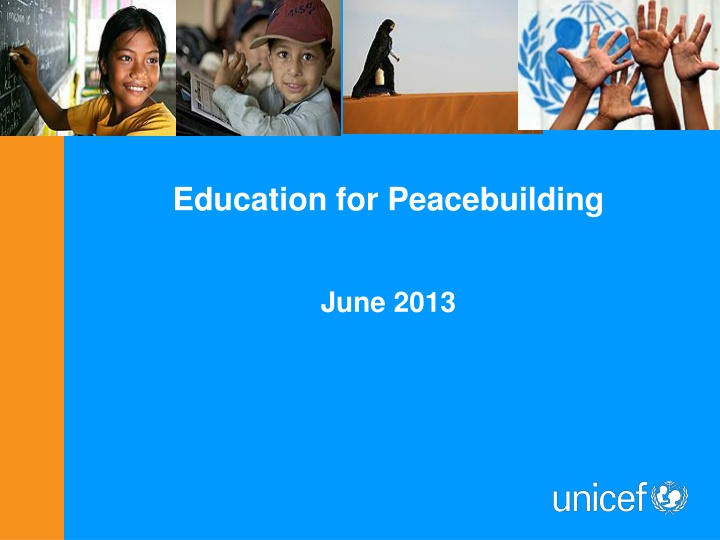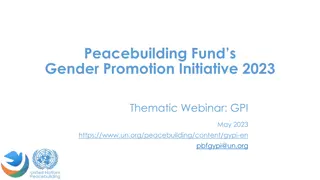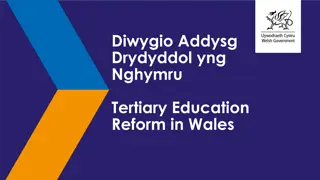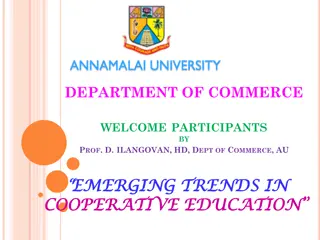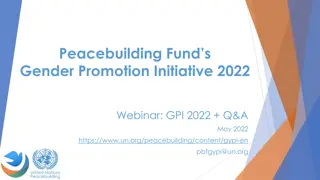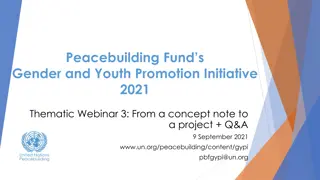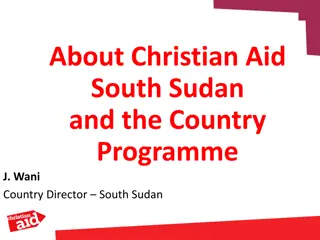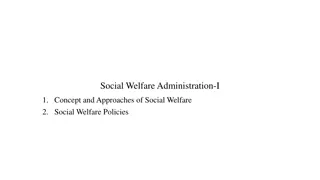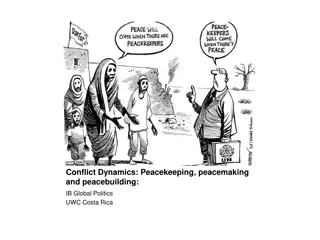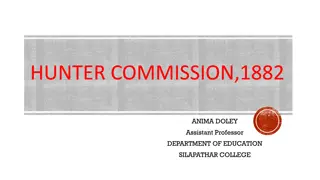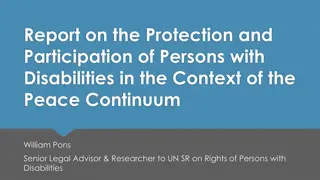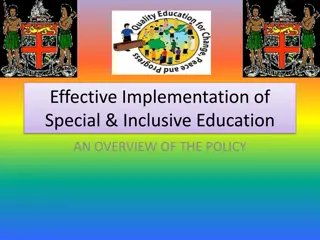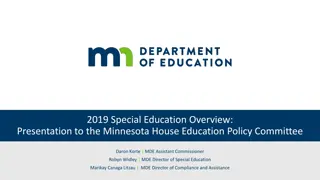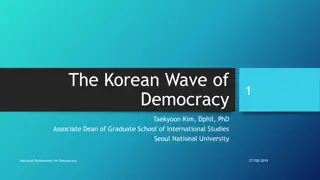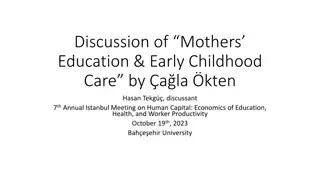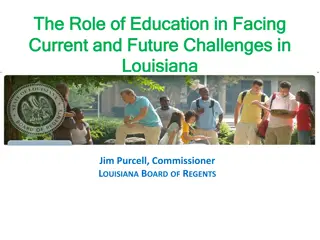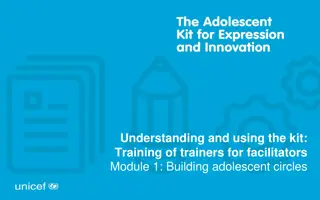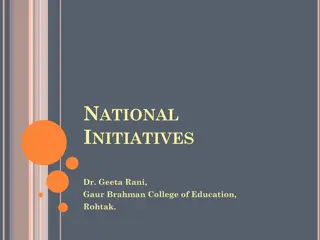Importance of Education in Peacebuilding
Educators should be interested in peacebuilding as over 1 billion children in conflict-affected areas need support. Peacebuilding involves addressing conflict causes and consequences. UN initiatives focus on safety, security, political processes, government functioning, revitalization, and social services. Education plays a pivotal role, either as a connector promoting development or as a divider reinforcing inequalities. It can be conflict-sensitive, progressive, and peacebuilding-relevant, contributing to relationship transformation.
Download Presentation

Please find below an Image/Link to download the presentation.
The content on the website is provided AS IS for your information and personal use only. It may not be sold, licensed, or shared on other websites without obtaining consent from the author.If you encounter any issues during the download, it is possible that the publisher has removed the file from their server.
You are allowed to download the files provided on this website for personal or commercial use, subject to the condition that they are used lawfully. All files are the property of their respective owners.
The content on the website is provided AS IS for your information and personal use only. It may not be sold, licensed, or shared on other websites without obtaining consent from the author.
E N D
Presentation Transcript
Education for Peacebuilding June 2013
Why should Educators be interested in peacebuilding? Over 1 billion children under 18 live in areas affected by conflicts and high levels of violence (often the countries furthest behind on achievement of MDGs) The impact of conflict on children is multifaceted: killing, maiming, mental health child recruitment and use gender-based violence separation, trafficking and illegal detention long-term development and well-being reinforces inequalities long-term exclusion of youth and adolescents HOWEVER, children and adolescents can make unique contributions to peace building on different levels
Peacebuilding General Definition Peacebuilding is essentially about conflict transformation, which means addressing underlying causes as well as consequences of conflict. * United Nations Children s Fund, Peacebuilding Literature Review (2011, May).
UN Peacebuilding Areas of Intervention Support to basic safety and security Support to political processes Support to restoring core government functioning Support to economic revitalization Support to provision of basic social services UNICEF (2011, December). The role of education in peace building. A synthesis report of findings from Lebanon, Nepal and Sierra Leone. New York: UNICEF, p. 9
Education and Peacebuilding Education Progressive? Conflict-sensitive education (do no harm)? Peacebuilding-relevant education that contributes to the transformation and strengthening relationships
Education: Connector or Divider? Education is a connector when it contributes constructively to + social development, economic development, political development + identity formation of citizens + social cohesion and state-building Education becomes a divider when - it is being provided inequitably to different groups - the curriculum is biased - Teachers and teaching methods that reinforce exclusion and stereotypes
Group Exercise a) Provide three examples where the Education System serves as a Connector between people and groups b) Provide three examples where Education is not conflict-sensitive, or divides people or groups rather than connecting them; AND suggest a remedy. Time available: 30 Minutes;
OVERALL GOAL - PBEA To strengthen resilience, social cohesion and human security in conflict affected contexts, including countries at risk of, or experiencing and recovering from conflict Strategic Result Strengthened policies and practices for education and peacebuilding in conflict affected contexts Outcomes 2 1 3 4 5 INSTITUTIONAL CAPACITY DEVELOPMENT Increased institutional capacities to supply conflict sensitive education. POLICY Increased inclusion of education into peacebuilding and conflict reduction policies, analyses and implementation. INDIVIDUAL CAPACITY DEVELOPMENT of children, parents, teachers and other duty- bearers to prevent, reduce and cope with conflict and promote peace PEACE DIVIDENDS Increased access to quality and relevant conflict sensitive education that contributes to peace RESEARCH Increased contribution to generation and use of evidence and knowledge in policies and programming related to education, conflict and peacebuilding Target Countries West and Central Africa: Chad, DRC, Sierra Leone, Liberia, Cote D Ivoire; East and Southern Africa: Burundi, Ethiopia, Somalia, South Sudan, Uganda; East Asia & Pacific: Myanmar; South Asia: Pakistan; Middle East and North Africa: Palestine, Yemen
Group Exercise a) As to conflict-sensitivity: How does Myanmar Education Policy need to adjust so that it can be called conflict-sensitive? What kind of learning is required to help education institutions in Myanmar work and perform in a manner that is conflict- sensitive ? What kind of training in what kind of thematic areas? What kind of education support do teachers, parents and children need to better cope with conflict and work towards peace? What kind of population groups are most in need of access to education opportunities that facilitate peacebuilding? What kind of education supplies and facilities and resources are needed to strengthen conflict sensitive education? What kind of peacebuilding challenge is not yet well-understood and should be researched further? b) c) d) e) Time available: 30 Minutes
Big Picture Linkages of education to other spheres Governance Social Security EDUCATION CESR Economic Environmental
Education Programming Entry Points (EXAMPLES) Peacebuilding Dimensions Focus areas Types of education programmes Security DDR (demilitarization, disarmament, reintegration) Security and police reform Community Safety Emergency/humanitarian programmes Child protection Refugee/IDP education Schools as safe spaces Political Political institutions Truth and reconciliation processes National dialogue efforts Elections Political freedoms Education sector reforms Education programmes about political / child rights Civic and citizenship education Involve youth in dialogue efforts Participation programmes Media education Social Institutional mechanisms for conflict resolution and social cohesion Community conflict transformation Psycho-social support Education programmes about social and cultural rights Education for Social Cohesion Economic Transforming weak economies/ conflict economies Addressing unemployment as a driver of conflict Governance: commitment of national budgets for education Skills development Youth employment Environmental Scarcity of resources and resulting conflict Disaster Risk Reducation Adapted in part from UNICEF (2011, December)
Key elements of conflict analysis Profile/Situation Analysis - snapshot Causal Analysis problem tree Stakeholder Analysis actors, relations, opportunities Analysis of Conflict Dynamics dividers and connectors, scenario planning Prioritization process against criteria derived from CA
The Conflict Mitigation Outreach Pyramid Level 1 (upper level) Military, political and religious leaders who are very much in the public eye Government representatives International organizations Level 2 (mid-level) Respected figures in certain sections of society Ethnic or religious leaders Academics, professionals Heads of NGOs Level 3 (grassroots level) Local leaders, elders, teachers NGOs and social workers Women s and youth groups Local health workers Refugees representatives Peace activists Note: The conflict pyramid is based on the distinction drawn by John Paul Lederach (1997) between the upper, mid and grassroots levels of conflict management and peacebuilding.
Leadership Backup for Sustainable Peacebuilding Sustainable peacebuilding can only be achieved if change is backed up by leaders at different levels of society (different levels of the pyramid from the previous slide) if the interventions and support from the different levels are interconnected in a strategic manner if different national and international partners work closely together to achieve a common objective Conclusion: Ministries needs backup of strategic partners to achieve peace building impact!
Enhancing Peacebuilding Capacity Source: PeaceNexus (2010, September)
Questions? Comments?
